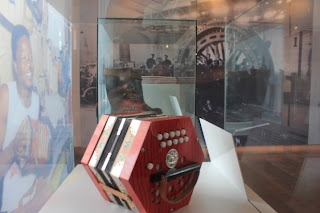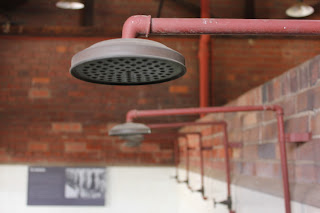The Workers
Museum is quite an anomalous site and more so as a reminder of an epoch that
sundered many unions of black souls, prostituted our forefathers strengths and
squeezed unheard sobs from our foremothers’ breasts. A haunting space where
perchance one could say, black masculinity was further denuded of its dignity,
in the grand project of dehumanizing black people. It is like a vortex of
spirits, where wails paint the mournful pale solitary confinement cells, disgraceful communal
ablutions, and the long queue of crimson showers hovering like gas pumps
reminiscent of Nazi concentration camps.
A square
for an eternal vigil our mothers’ expectant bosoms hold even in death, where in
sleep, their walks always tread walls of a cold monument. This stands for a
tombstone of their children’s dreams that perished with their fathers disgraced.
Sombre is
the mood it arouses, yet there is a glimmer of light in the sad fires of memory
that says; never again would the fabric of the black family be squandered for
weaving the blood-drenched robe of the oppressor’s gown of glory.
The place was built in 1913, which synchronously seems to coincides with land dispossessions put into law through the infamous Natives Land Act, the lure of cheap labour to the city of gold, a year after the founding of the African National Congress which speared-headed a formative confrontation against a system of oppression that favoured a minority of whites. Records have shown the appalling conditions at this compound and hostel, which was initially utilised to house the city’s Cleansing and Sanitary Staff, re-designed to house 330 workers by the beginning of 1927. As one of a few remaining compounds that were run by the Johannesburg municipality, the compound remained operational until as recently as the early 80's, and was finally converted into a storage facility later in that decade.
Now, a
heritage site under the Johannesburg City Municipality, the museum houses a
variety of exhibitions. The resident exhibition entails photographic depiction
of life in the compounds and hostels of past times, audio-visual recordings of
workers who lament scarring separations from their families and an exhibition of Jurgen Schaderberg’s images from the historic
Sophiatown times, which vibrantly mirror an innate cultural component instilled
into compound life by the migrant labourers. Over and above boasting abundant
space for conferences, workshops, and a gallery space, the compound is
incidentally hosting an exhibition of artwork by renowned weaver and
print-maker, Phumzile Buthelezi August.
Images of The Compound
Squat
toilets, with no doors or partitions.
One
latrine provided for every 41 men
One cold
shower for every 36 men.
The beds
were of a two tier system - the lower bunk a concrete shelf, and the upper one,
a wooden shelf.
The lock-up room
Rules
were severe
"When you make
noise past the noise hour, it was an offence.
If you wake up before
time, it was an offence.
If you miss work, it
was an offence.
So was having a
fight!
But being beaten up
by the Compound Manager was a better punishment than losing one's job."
Sidney Moloi, former
Newtown Compound resident, 2009
Standing
in solitary inferiority among colossal buildings that pierce the Johannesburg
skyline; the Worker’s Museum embodies a time capsule that teleports souls into
spaces that have a million stories untold. Located at the heart of the Newtown
Cultural Precinct, the compound, together with the nearby cottages for white
workers, was declared a national monument in 1996 and by 2009, the buildings
were extensively renovated, and the exhibition installed. Through this
exhibition, glass-caged fragments of a past community of victims and soldiers
are frozen and left for memory to resuscitate them back to ghostly life. A
kraal for our fallen ancestors who toiled for a hope of descendants made of a
flourishing people. It is a sanctum for dethroned kings, whose Queens held onto
crowns in hope of a return to the homelands.
And it is
with fond nostalgia for the Khanya
College days, when the museum was home to poets and writers, a pool of
knowledge in a library once managed by PO
Sekele among other young progressive minds, that I write this piece. These
walls witnessed the birth of The
Muthaland Funk, revolutionary voices that consumed Marxist pamphlets and
subversive literature in place of totalitarian newspaper columns.
The halls still echo with utterances by scribes such as Mak Manaka, the strife ridden voice of Motho Fela and the now sprawling breed of black thinkers guiding a nation through turbulent times. Reclusive voices of Johannesburg’s underbelly found an exorcised stage with ripened ears, the tormented and dispossessed brought tongues to the introverts and the bleeding heart of post-apartheid youth gave birth to itself. The landless and foreign to an intelligence that bred their present conditions, studied and discussed philosophy from shredded books donated by anonymous faces and wrote manifestos.
This was
the Worker’s Library, a place that also lives in the chapters of a story
carried by this revered place. It was in
the past our fathers’ masked anarchy that was scribbled as anthems of lament on
these walls, and during the heydays of performances and screenings of pertinent
films, young voices of protest produced not eulogies but political poetry,
music and theatre in homage to the fallen.
OPENING
TIMES:
Tuesday –
Sunday: 09h00 – 17h00 (9.00am - 5.00pm)
Closed on
Mondays, Good Friday and 25th & 26th December
MUSEUM
CONTACT:
Telephone
: +27 (0)11 492-0600/-1865
Fax : +27
(0)11 492-0618
Photographs by: Khahliso Matela
Photographs by: Khahliso Matela


























































No comments:
Post a Comment